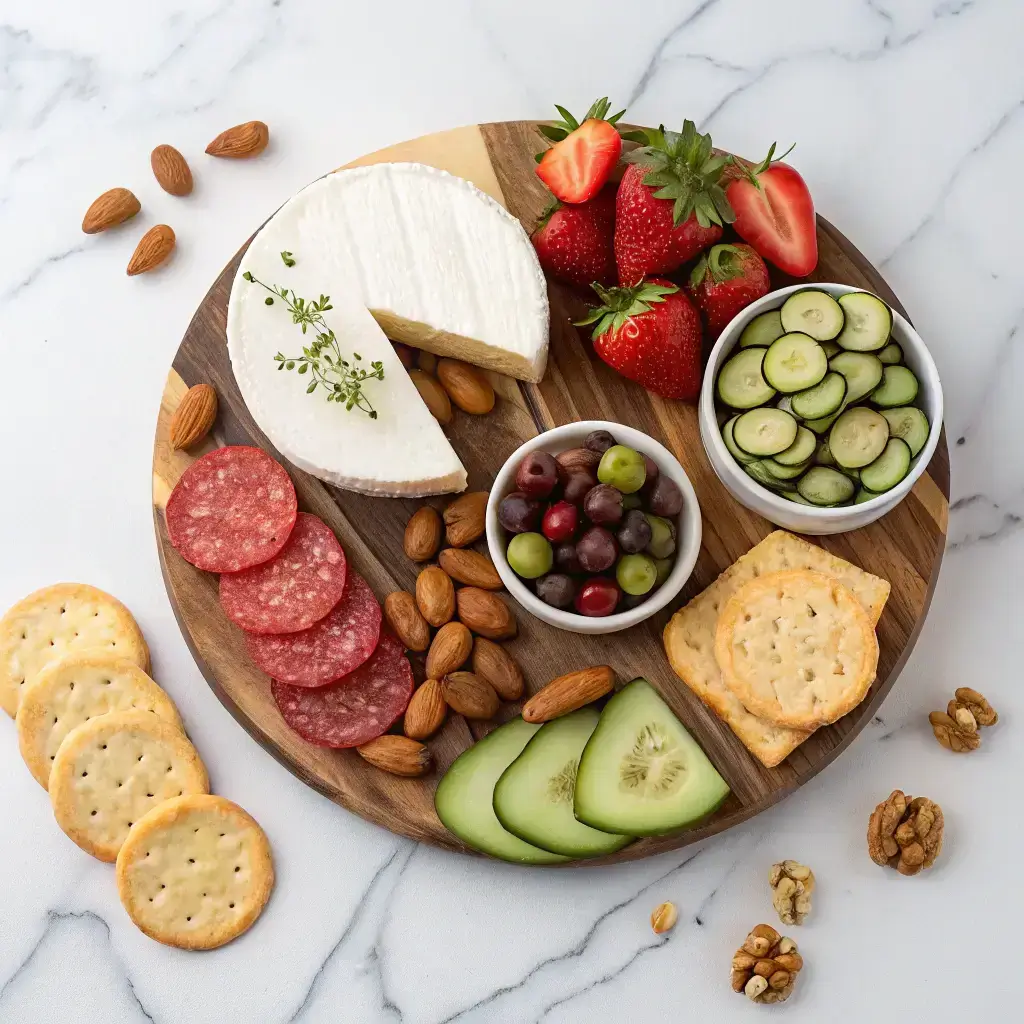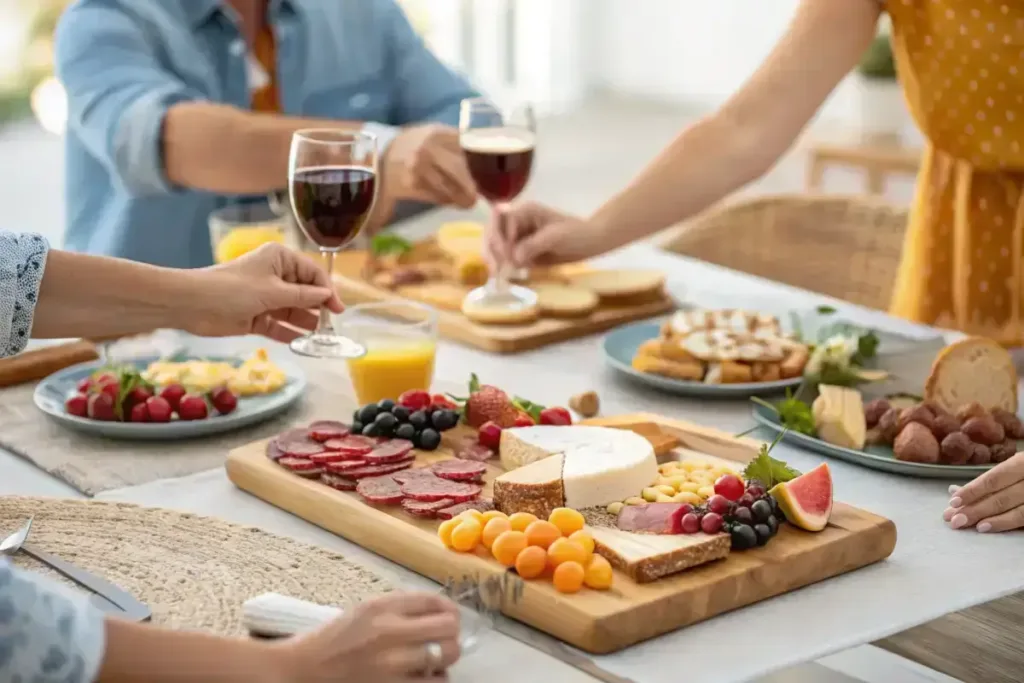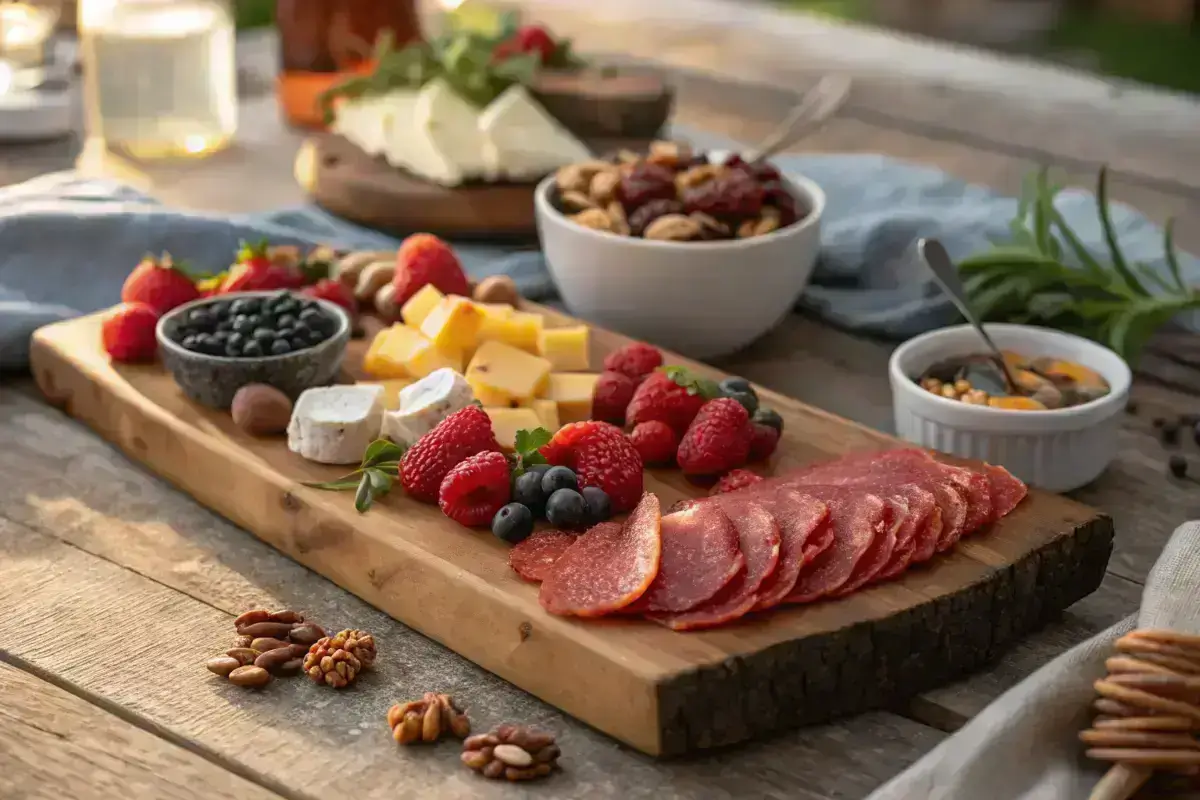If you’re looking for fun, beautiful, and unique charcuterie board ideas, you’re in the right place. Whether it’s a cozy brunch with friends or a keto-friendly snack tray for your weekend movie night, there’s something special about arranging food with intention and color. In this article, I’ll guide you through board-building basics, creative themes, expert tips—and a few things to avoid. From classic meats and cheeses to unexpected breakfast and dessert spreads, you’ll walk away ready to craft a board that impresses. Let’s make your next gathering (or solo night in) unforgettable—with charcuterie.
In This Recipe
How I Fell in Love with Charcuterie Board Ideas
It all started the year I turned 49. I had just discovered the keto lifestyle and was finally feeling like myself again—energized, lighter, joyful. Food was no longer something I feared. It became something I celebrated. And that’s when I made my first charcuterie board.
It was a chilly Sunday in Oregon, and a few girlfriends came by for a low-key brunch. Instead of a formal meal, I laid out a wooden board and filled it with berries, prosciutto, soft goat cheese, a few almonds, and low-carb crackers I’d made that morning. I didn’t overthink it—I just picked foods I loved. When I brought it to the table, my friends gasped. “This looks amazing!” one said. Another added, “You need to post this online.” That little board started it all.
Soon I was experimenting with new charcuterie board ideas every weekend—keto-friendly ones, of course. I tried a Valentine’s Day dessert board with dark chocolate and strawberries, a bagel brunch board with smoked salmon and sliced radishes, and even a taco salad platter that doubled as dinner. What began as a simple way to share food became a joyful ritual—and one I now love to teach others.
Charcuterie board ideas are more than trendy—they’re a fun, flexible way to make food look beautiful, no matter your dietary lifestyle. And if you’re following keto like me, yes, you can absolutely make it work. From sweet to savory, from casual to show-stopping, there’s a board for every mood and moment.
And the best part? There’s no single way to do it. You can customize your board to match your theme, diet, or pantry. The key is to start with balance—and a little creativity.
Building Blocks of a Beautiful Charcuterie Board
The 3-3-3 Rule: A Foolproof Formula for Balance
Let’s talk about one of the easiest ways to get started with charcuterie board ideas—the 3-3-3 rule. It’s a beginner-friendly formula that helps you build a balanced, Instagram-worthy board every single time. Here’s how it works:
- 3 cheeses: Mix textures—one soft (like brie or goat cheese), one hard (cheddar or manchego), and one unique (blue, herbed, or spicy).
- 3 meats: Choose a variety—salami, prosciutto, and something unexpected like peppered turkey or bresaola.
- 3 starches: This could be low-carb crackers, toasted nuts, or sliced cucumbers if you’re keeping it keto.
You can use this same rule for themed boards too. A dessert board might include 3 types of chocolate, 3 fruits, and 3 sweet dips. A breakfast board? 3 types of carbs (like waffles, mini bagels, and toast), 3 proteins (bacon, eggs, sausage), and 3 spreads or toppings.
The 3-3-3 rule takes the guesswork out of building a board and keeps everything feeling organized yet abundant.
What to Always Include on a Charcuterie Board
While boards can be themed in a million ways, there are a few classic staples that anchor any great spread. At a minimum, include:
- Cheese: Variety is key—aim for at least one soft and one firm.
- Cured meats: Salami, prosciutto, or even smoked sausage work well.
- Crackers or alternatives: Use almond crackers or sliced jicama for low-carb options.
- Fresh fruits: Berries, grapes, or apple slices (or strawberries and raspberries for keto).
- Nuts and extras: Almonds, walnuts, olives, pickles, and fresh herbs make beautiful fillers.
- A spread or two: Think Dijon mustard, fig jam, or a garlic herb spread.
Remember: it’s not just about what goes on the board—it’s about how you lay it out. Layer different heights, colors, and textures to give your board visual interest. Use tiny bowls for dips and spreads, and let your ingredients spill naturally for that casually elegant look.
Creative Charcuterie Board Ideas for Any Occasion
Seasonal and Holiday Charcuterie Themes
Charcuterie isn’t just for dinner parties anymore. One of the most exciting things about charcuterie board ideas is how you can match them to any holiday or season. For Christmas, imagine a red-and-green spread with rosemary sprigs, cranberry goat cheese, salami roses, and star-shaped cucumber slices. Add white cheddar cubes and keto-friendly chocolate for a snowy touch.
Valentine’s Day boards are another favorite—strawberries, dark chocolate, raspberries, and pink-hued cheeses like port wine cheddar make the board festive and romantic. For Easter, try deviled eggs, pastel-colored dips, carrot sticks, and fresh herbs.
In fall, go cozy with roasted nuts, baked brie, figs, and apple slices (or a low-sugar substitute). You can even try a hot cocoa board in winter—marshmallows, whipped cream, sugar-free chocolate bark, and cinnamon sticks nestled in between mugs of warm drinks.
Theme boards help you keep things fresh all year and can be tailored to your eating style, whether traditional or low-carb.

Unexpected Charcuterie Ideas to Wow Your Guests
The world of charcuterie board ideas goes far beyond meats and cheeses. You can make a stunning board out of almost anything, and your guests will love the surprise.
Breakfast boards are trending—and for good reason. Try waffles cut into quarters, hard-boiled eggs, turkey bacon, avocado slices, and little bowls of cream cheese or almond butter. Add fresh berries and keto maple syrup for a brunch your guests won’t forget.
Taco or nacho boards are perfect for game day. Lay out small bowls of seasoned ground beef, lettuce, cheese, salsa, sour cream, sliced jalapeños, and keto tortillas or cheese crisps. Let everyone build their own bite.
Dessert boards are also pure fun. Think sugar-free chocolate, fresh strawberries, coconut truffles, almond butter cups, and keto cheesecake bites. These are a hit at birthday parties, showers, or girls’ night in.
Want to get really unique? Try a sushi board, a baked potato toppings board, or even a donut board (with keto donuts, of course). The point is: if you can snack on it, you can make a board out of it.
Whether you’re hosting brunch, celebrating a holiday, or having a low-key night at home, these creative boards make any occasion feel special.
What to Avoid + Pro Tips
Common Mistakes to Avoid When Building a Board
Even the most beautiful charcuterie board ideas can fall flat if a few key details are overlooked. Here are five mistakes to steer clear of when assembling your spread:
- Lack of variety
Sticking to one texture or flavor—like all hard cheeses or all salty items—makes the board feel flat. Mix soft, creamy elements with crunchy, chewy ones. Sweet items balance salty components beautifully. - Overpowering aromas
Strong cheeses like Limburger or very spicy meats can dominate the entire board. Unless you know your crowd loves bold flavors, stick with crowd-pleasers like cheddar, gouda, or brie. - Sticky or soggy items next to dry ones
Keep wet items like pickles, jams, or fruit away from crackers and bread, or place them in bowls. This prevents texture-killing sogginess. - Too many items crammed together
While abundant boards look gorgeous, overcrowding can make it hard for guests to grab what they want. Leave small gaps and group similar items in clusters for both function and aesthetics. - Forgetting dietary preferences
Be sure to consider guests’ needs. For example, include nut-free zones, vegetarian-friendly spots, or use low-carb options if someone follows keto like I do.
Small mistakes can affect the guest experience—so a little planning goes a long way.
5 Expert Tips for Making a Beautiful and Functional Board
Now for the fun part. These five tips will help you turn your charcuterie board ideas into a true showpiece—whether you’re serving two people or twenty.
- Start with structure
Use small bowls or ramekins to anchor the board. Fill them with dips, olives, nuts, or berries. This creates visual height and gives the layout natural flow. - Mix textures and colors
Combine smooth and rough surfaces, crunchy and creamy foods, and at least 3–4 colors. Fresh herbs like rosemary or basil make easy and beautiful garnishes. - Pre-cut everything
Slice cheese, meats, and fruits into bite-size pieces. This makes it easier for guests to serve themselves—and helps keep your board looking tidy. - Include the right tools
Add cheese knives, toothpicks, or tiny tongs for each section of the board. This keeps things sanitary and allows for easy serving. - Build in layers
Instead of laying everything flat, stack some crackers, fan out your meats, and curl prosciutto or salami to create texture.
Remember, there’s no “perfect” way to build a board—only the one that fits your style, theme, and occasion. A little creativity and intention can turn a simple snack board into a centerpiece.
FAQs About Charcuterie Board Ideas
What is the 3-3-3 rule for charcuterie boards?
The 3-3-3 rule is a simple formula to build a well-balanced charcuterie board. It stands for three types of cheese, three types of meat, and three types of starches or vehicles (like crackers or low-carb bread). You can also adapt this rule for dessert or brunch boards by switching in sweet items or breakfast proteins. It’s a go-to method for making any board look abundant and organized.
What usually goes on a charcuterie board?
Classic charcuterie board ideas usually include cheeses, cured meats, crackers or bread, fresh or dried fruit, nuts, olives, pickles, and spreads like mustard or jam. For keto-friendly versions, substitute high-carb items with cucumber slices, nuts, sugar-free dips, or keto seed crackers. The goal is to offer a variety of textures, flavors, and colors.
What are 5 things to avoid on a charcuterie board?
Overpowering smells (too much blue cheese)
Soggy or wet ingredients next to dry ones
Repeating the same texture (all soft cheeses, no crunch)
Cramped, messy layout
Ignoring dietary restrictions like gluten-free or keto options
Avoiding these mistakes ensures your board looks and tastes amazing for everyone at the table.
What are 5 tips to making a charcuterie board?
Use small bowls to anchor your layout
Mix colors and textures for visual appeal
Pre-slice everything for easy serving
Include at least one sweet or acidic element to balance richness
Keep tools like small knives and toothpicks nearby for convenience
Following these tips will turn any of your charcuterie board ideas into a standout centerpiece.

Let Food Be a Joy Again
When I started building charcuterie boards, I wasn’t chasing trends—I was rediscovering joy in food. These boards became a way to share flavor, friendship, and creativity all in one place. Whether you’re whipping up a casual keto snack tray or crafting a full-blown brunch masterpiece, the best charcuterie board ideas are the ones that feel personal.
Remember, progress matters more than perfection. So start small, trust your taste, and let your board reflect what you love. If food is art, this is your canvas.
